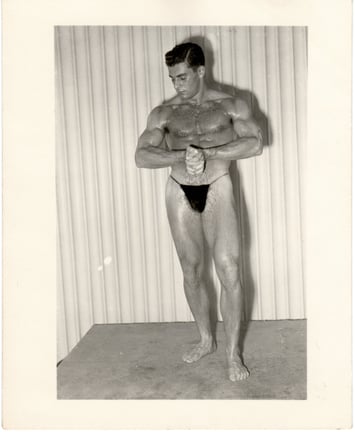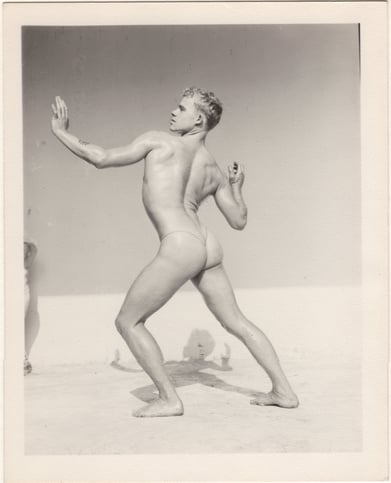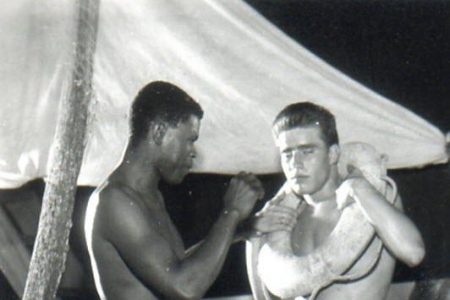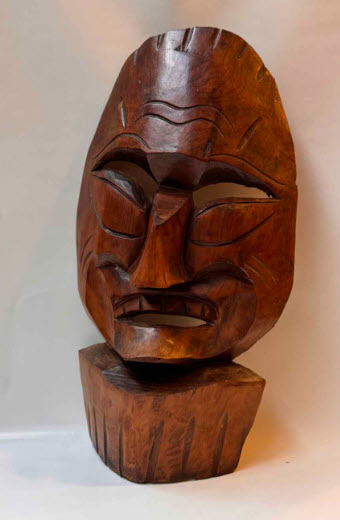Behind the Lens: The Life and Times of Bob Mizer (Part III)
Author’s note: This is the third part of a four-part series designed to introduce the novice to photographer and filmmaker Bob Mizer. We will post a...
4 min read
Bob Mizer Foundation : Feb 16, 2016 3:43:00 PM

Author’s note: This is the fourth and final part of a four-part series designed to introduce the novice to photographer and filmmaker Bob Mizer. Part IV will explore the founding of The Bob Mizer Foundation and examine Mizer's lasting legacy to the art world.
It was a low-key, unceremonious end to a life lived out loud. When Bob Mizer died in May 1992, his legacy nearly died with him.
 Things seemed to fall apart almost immediately. Mizer’s brother, Joe, had inherited the estate but died only a month after Bob, in June 1992. Over the next two years, workers hauled old mattresses and broken props to dumpsters, all the while supervised by Wayne Stanley, Mizer’s live-in assistant manager and second beneficiary. A good portion of Mizer’s personal possessions, as well as costumes, props and equipment found their way to the dumpsters as well – by Stanley’s own estimates, between 16 and 33 dumpsters full of what he deemed ‘junk’ were transferred to the city dump.
Things seemed to fall apart almost immediately. Mizer’s brother, Joe, had inherited the estate but died only a month after Bob, in June 1992. Over the next two years, workers hauled old mattresses and broken props to dumpsters, all the while supervised by Wayne Stanley, Mizer’s live-in assistant manager and second beneficiary. A good portion of Mizer’s personal possessions, as well as costumes, props and equipment found their way to the dumpsters as well – by Stanley’s own estimates, between 16 and 33 dumpsters full of what he deemed ‘junk’ were transferred to the city dump.
“It’s frightening to think about how close we came to losing Mizer’s work, the sheer volume of which was a testament to the scope of his legacy,” recalls Dennis Bell, founder and president of the Bob Mizer Foundation. “Much of what wasn’t discarded was saved by Bob’s friend, the painter John Sonsini, as well as friends. Even now, many items from Mizer's estate turn up for sale online. It was as if the AMG compound had erupted like a volcano, spewing vintage porn all over the country.”
Stanley did his best to maintain Mizer’s compound and continue the work he never really got to finish, shooting AMG models in the same spirit as his dearly departed friend. But by 1994, the day-to-day rigors of keeping the business going began to wear on Stanley, and he began the seemingly endless process of cleaning up the properties. Mizer’s animals were removed, and so were most of the models who were still living within the compound. Stanley had kept on Ed Taylor, however, a Mizer favorite who took care of the photographer in the last years of his life.
It took a year and a half for Stanley to sell off the properties, after which time he moved to Alameda, California. Mizer’s remaining black-and-white still image negatives and prints were kept in Stanley’s garage, the color photos (and, later, back issues of “Physique Pictorial”) were transferred to a storage unit, and his films and videos were housed on deposit to the Academy of Motion Picture Arts and Sciences.
More than a decade after Mizer’s death, his works, which had been spread across the miles, would be reunited when professional photographer Dennis Bell purchased the Mizer estate from Stanley. Bell, who had previously worked as a photographer for Falcon Studios and had launched the internet's first membership website, PosingStrap.com, as a homage to vintage physique photography in 1997, finalized the negotiation with Stanley by late 2003, and the Mizer legacy was at last his to resurrect.
 “That was a real labor of love,” Bell says. “I had loved Mizer’s work for years, and I was thrilled to have the opportunity to preserve his memory. It was all about to be lost, because Stanley was about to break up the estate and sell it off to collectors. I had to hunt down several chunks that had already been sold, explain my mission and reconnect those pieces to the estate. Today, Mizer's photographic legacy is virtually intact. It did take awhile to finalize the purchase and the transfer of Mizer’s estate, but it was absolutely worth it.”
“That was a real labor of love,” Bell says. “I had loved Mizer’s work for years, and I was thrilled to have the opportunity to preserve his memory. It was all about to be lost, because Stanley was about to break up the estate and sell it off to collectors. I had to hunt down several chunks that had already been sold, explain my mission and reconnect those pieces to the estate. Today, Mizer's photographic legacy is virtually intact. It did take awhile to finalize the purchase and the transfer of Mizer’s estate, but it was absolutely worth it.”
Bell founded the Bob Mizer Foundation in 2010 – a nonprofit organization dedicated to “promoting and preserving the works of progressive and controversial photographers.” Based in El Cerrito, Calif., the foundation relies on grants and the generosity of donations from members to fund its preservation efforts.
The elaborate puzzle of cataloguing, filing and storing Mizer’s photos, slides, films and magazines is ongoing, and Bell certainly isn’t alone in his management of the Foundation. Bell supervises a staff of volunteers and interns who both work on site and remotely. According to Bell, volunteers participate in a variety of tasks, from sorting and filing photo slides to writing press releases to updating the Foundation’s website. In addition to its website, the Foundation has a social media presence on Facebook and Twitter, among others.
Thanks to the Foundation’s aggressive promotional efforts, both the art world and patrons of experimental photography have taken a renewed notice in Mizer’s work. Since the Foundation’s infancy, major cities around the world, from London to Berlin to New York City to Chicago, have hosted solo and group exhibitions that bring Mizer’s work to life for a new generation of art enthusiasts. From coast to coast and across the pond, Mizer’s films have played in film festivals and other screenings for audiences since 2008. And countless news outlets and art periodicals have recounted the story of Mizer’s empire in their pages and online, including The New York Times and The Huffington Post.
Within the realm of experimental photography, the Foundation continues to encourage photographers to share works that shock, surprise, titillate and generate debate. The Foundation’s second annual Emerging Photographers Competition, in fact, is wholly designed to showcase the work of photographers and artists who embody Mizer’s same progressive spirit.
 “This is all evidence of a renewed interest in Mizer, and I always find it exciting when someone discovers Mizer’s work for the very first time,” Bell says. “He was relentless in pushing societal boundaries, and he worked tirelessly to do so.”
“This is all evidence of a renewed interest in Mizer, and I always find it exciting when someone discovers Mizer’s work for the very first time,” Bell says. “He was relentless in pushing societal boundaries, and he worked tirelessly to do so.”
The Foundation’s future is robust, with multiple projects on the docket for the coming year, according to Bell.
“I can’t talk much about them, but 2016 is going to be a huge year for us,” he says. “Of course, we can’t do what we do without the help of our members, volunteers, interns and supporters.”
Bob Mizer’s vision of the beauty of the male form, of presenting masculinity in new and exciting ways, in combining the aesthetic and the erotic in a perfect marriage of art, are proof that he was ahead of his time. And while mainstream society couldn’t fully appreciate him – and even persecuted him – in life, Mizer’s work is undergoing a renaissance in this, the years following his passing.
“Bob Mizer gave so much to the art world, to artists themselves, to the gay community, and we are still learning from him, even after all this time,” Bell notes. “He simply did what he thought was right regardless of the consequences. We’ve only begun to explore the scope of his influence. There’s still so much more to be done, more to discover and more to appreciate.”

Author’s note: This is the third part of a four-part series designed to introduce the novice to photographer and filmmaker Bob Mizer. We will post a...

Bob Mizer counted many people among his friends and acquaintances. His compound -- especially in the later years of his career -- was always buzzing...

Author’s note: This is the second in a two-part series about the props, costumes and scenery used in Bob Mizer’s photos and films.

Racial diversity has long been displayed in Bob Mizer’s Physique Pictorial – since the publication’s infancy, in fact. The increasing number of...